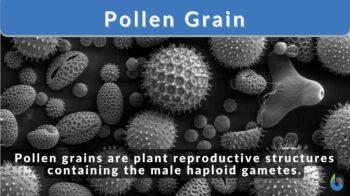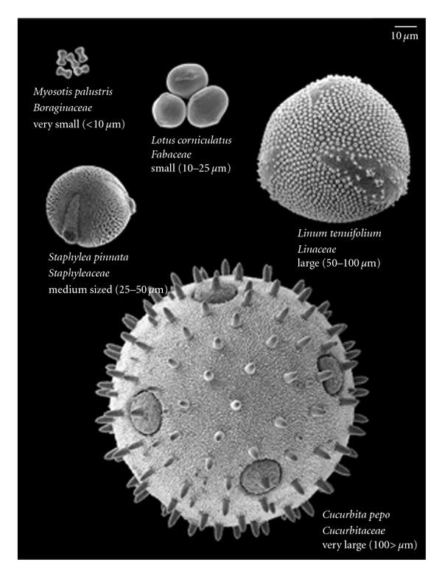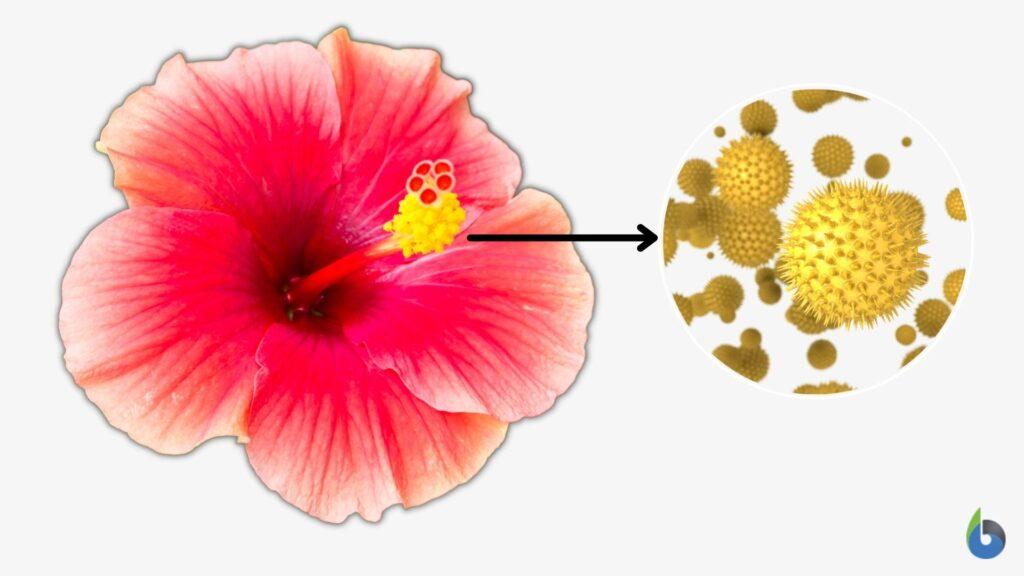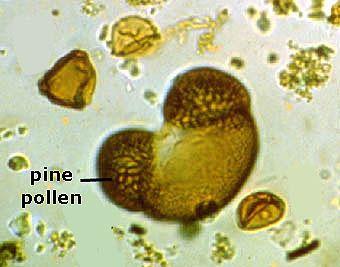
Pollen grain
n., plural: pollen Grains
[ˈpɑlən ɡɹeɪn]
Definition: a small collection of microspores
Table of Contents
What are Pollen Grains?
Plants are unique structures and so they carry out mechanisms in special ways. Fertilization in some plants occurs via the pollen grains of the flower. What is pollen grain? How can one define pollen grain?
By definition in biology, pollen grain is a collection of microspores that assists with plant fertilization. Another name for pollen grain is microspore. Pollen grains are found in flowering plants, in the male structures. What produces pollen grains and where are pollen grains produced? Pollen grains are produced by the male structure of the flower and pollen grains are produced in, specifically the anther of flower-bearing plants (angiosperms) or in the microsporangia of gymnosperms. The structure of pollen grain assists with their function. The function of the pollen grain is to carry or transfer the male gametes of the plant to the female reproductive structure of the plant so that fertilization can occur. This brings about the importance of pollen grains, as fertilization of some plants would not be able to occur without these.
What helps to bring pollen grains to the stigma? During cross-pollination, different biological agents help to bring the pollen grains across to the stigma. This includes winds, water, and animals (mainly birds and insects). Animals that assist with pollination are called pollinators.
The study of pollen grains is called palynology. It assists in the study of animal diets, human allergies, and when archeological shipwrecks are excavated. Pollen products or what pollen grains help to produce are usually seeds and fruits on most plants.
What is an example of pollen grain? Examples of pollen grains can include rose pollen grain and pollen grains in Hibiscus. These are flower pollen. They can also be cycad pollen grains, which are non-flowering pollen grains. Figure 1 below shows various pollen grains under the microscope.

A pollen grain is a small collection of microspores that aid in fertilization and sexual reproduction in plants. It is attached to the anther of the male reproductive organ of the plant. Through self-pollination or by cross-polination through the assistance of pollinators, the pollen grains are brought to the pistil containing the egg cells located inside the ovules. Synonym: microspore; microgametophyte.
Pollen Grains Structure
Pollen grains are formed from the process of microsporogenesis. Pollen grains are formed by which division in locules of anthers? The development of pollen grains takes place using meiosis division in the pollen cells. Microspores are then separated from the tetrads and these separations are what form pollen grains. The morphological structure of pollen grain consists of one or more vegetative cells and the male gamete cell. The mature pollen grain develops at different levels and so has different numbers and kinds of cells. A matured pollen grain consists of a pollen tube cell and a generative cell – only two cells. When germination occurs, the pollen tube cell will become the pollen tube and the generative cell will go to the ovaries of the plant.

The outer wall of the pollen grain is made up of exine and the inner part consists of intine. The exine is extremely strong and build to withstand the elements. Intine usually contains cellulose or hemicellulose. The intine will emerge as the pollen tube out of one of the pores of the exine in a germinating pollen grain. When the pollen grain under the microscope is measured, the size of pollen grain in myosotis is usually about 2.5-5μm in diameter. It is the smallest pollen grain known. The largest pollen grain is the Zostera grain which can get as long as 2500μm. Pollen grains are not only minute, but usually light as well so they are able to be easily transported by water, wind, or pollinators.
Types of Pollen Grains
Pollen grains are formed in many different types of ways. Pollen grains can be classified based on the orientation of the furrows in reference to the original tetrads from the microspores. These can be either sulcate or colpate. Sulcate has the furrow running across the middle. One sulcus is monosulcate, two are bisulcate and more than two are polysulcate. The colpate has a furrow that runs in other places besides the middle of the outer face. If they are two or more fused at the ends they are syncolpate and if they are not fused they are polycolpate. Some pollen grains may be tricolpate pollen grain. This means they have three colpi or a shape that is similar to that of tricolpate evolutionary derived pollen.
Pollination in Angiosperms
Pollination in angiosperm is the distribution of pollen grains from the anther of one plant, to the stigma of another plant of the same plant. This means that angiosperms undergo both cross-pollination and self-pollination. Self-pollination occurs when flowers are fertilization by themselves (the same flower on the same plant) and cross-pollination occurs when the pollen grains of another flower pollinate the flower of a different plant. Pollen grain transfer usually happens using biotic agents such as wind, water, or animals – insects and birds mainly. In terms of the structure of the pollen grains, when pollen grains do not separate in the tetrads, they form compound pollen grains. These are the pollen grains present in more angiosperms.
Pollination in angiosperms typically is small flowering plants such as rose and hibiscus plants. The rose pollen grains are usually fine, yellow dust that is easily transferable by wind or animals. It is elliptical in shape and adapts well to certain environments. This is much different from pollen grains in the hibiscus. These pollen grains tend to be more spherical in shape and are bigger than the average pollen grain, getting about 80 – 180 µm in diameter, much bigger than the rose (which averages 20-50µm). A hibiscus flower and pollen grain are shown below in figure 3.

Pollination in Gymnosperms

Pollen grains are produced in the microsporangia of gymnosperms. Gymnosperms pollinate by pollen grains from the male cone being transferred to the female cone. When this occurs then pollen grain will then germinate. After germination occurs, the pollen tube is formed and the female productive gamete can then be fertilized. The main mode of transfer of the pollen grain in gymnosperms is wind. This is because cones are not typically visited by animals and insects since they do not contain nectar. The structure of the pollen grains of gymnosperms typically contains little air sacs or vesicles called sacci. These are clearly noted in the pinus pollen grain, which contains two sacci.
Gymnosperms are the plants and trees that typically do not bear flowers, this is why their pollen grains are not produced in the anther. The ovules of the gymnosperms are able to secrete a pollination fluid that helps to attract pollinators. These pollinators can then bring the pollen grains across to the male cone. This method is found in trees like ginkgo and conifers. All gymnosperms are still able to get pollinated by wind, where the pollen grains are blown onto the male cones or by water, such as rain – which brings the pollen grains to the male cone when it flows.
Try to answer the quiz below to check what you have learned so far about pollen grains.
References
- Compound pollen grains occur in . (n.d.). Toppr Ask. Retrieved February 20, 2022, from https://www.toppr.com/ask/en-bt/question/compound-pollen-grains-occur-in/
- egg3. (n.d.). Pollen is… —University of Leicester [Page]. Retrieved February 20, 2022, from https://www2.le.ac.uk/departments/genetics/people/twell/lab/pollenis
- El-Amier, Y. A. (2015). Morphological studies of the pollen grains for some hydrophytes in coastal Mediterranean lakes, Egypt. Egyptian Journal of Basic and Applied Sciences, 2(2), 132–138. https://doi.org/10.1016/j.ejbas.2015.04.001
- Frontiers | The Evolution of Sexual Fluids in Gymnosperms From Pollination Drops to Nectar | Plant Science. (n.d.). Retrieved February 21, 2022, from https://www.frontiersin.org/articles/10.3389/fpls.2018.01844/full
- Full article: Pollen morphology of Pinus (Pinaceae) in northeast China. (n.d.). Retrieved February 20, 2022, from https://www.tandfonline.com/doi/full/10.1080/21580103.2012.704973
- Giovannini, A., Macovei, A., Caser, M., Mansuino, A., Ghione, G. G., Savona, M., Carbonera, D., Scariot, V., & Balestrazzi, A. (2017). Pollen Grain Preservation and Fertility in Valuable Commercial Rose Cultivars. Plants, 6(2), 17. https://doi.org/10.3390/plants6020017
- Liu, L. (2016). Ultramicroscopic Characterization of Mature Pollen Grains of Habenaria sagittifera. Horticultural Plant Journal, 2(1), 50–54. https://doi.org/10.1016/j.hpj.2016.02.003
- Pacini, E., & Franchi, G. G. (2020). Pollen biodiversity – why are pollen grains different despite having the same function? A review. Botanical Journal of the Linnean Society, 193(2), 141–164. https://doi.org/10.1093/botlinnean/boaa014
- Palynology. (2017, April 11). Florida Museum. https://www.floridamuseum.ufl.edu/paleobotany/palynology/
- Pollen. (2022). In Wikipedia. https://en.wikipedia.org/w/index.php?title=Pollen&oldid=1071855798
- Pollen | Description, Characteristics, & Facts | Britannica. (n.d.). Retrieved February 20, 2022, from https://www.britannica.com/science/pollen
- Pollination and Fertilization | Biology II. (n.d.). Retrieved February 20, 2022, from https://courses.lumenlearning.com/biology2xmaster/chapter/pollination-and-fertilization/
- Sexual Reproduction in Angiosperms | Biology for Majors II. (n.d.). Retrieved February 21, 2022, from https://courses.lumenlearning.com/wm-biology2/chapter/sexual-reproduction-in-angiosperms/
- Where Are Pollen Grains Produced—BYJU’S NEET. (n.d.). BYJUS. Retrieved February 20, 2022, from https://byjus.com/neet-questions/where-are-pollen-grains-produced/
©BiologyOnline.com. Content provided and moderated by Biology Online Editors.




